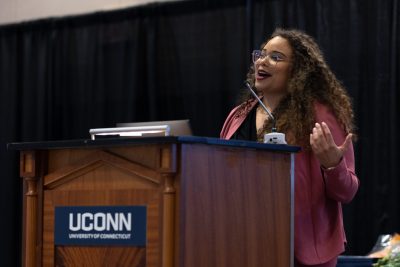As the body ages, a network of proteins and other molecules may structurally change, leading to a loss of elasticity and tissue strength in skin, joints, and arteries. This can lead to reduced muscle mass, stiffness, and increased susceptibility to chronic diseases like osteoarthritis.
 Anna Tarakanova, assistant professor of mechanical engineering and biomedical engineering, leads a research group in UConn’s College of Engineering (CoE) that uses advanced computer models to study the mechanical properties of proteins.
Anna Tarakanova, assistant professor of mechanical engineering and biomedical engineering, leads a research group in UConn’s College of Engineering (CoE) that uses advanced computer models to study the mechanical properties of proteins.
In doing so, she’s developing nature-inspired materials that can mimic the flexibility of elastin or the durability of collagen. These designs could lead to innovations in medical devices, prosthetics, or even “repurpose” molecules for resilience in aging.
“Ultimately, our goal is to understand aging and disease at a basic, molecular level and how that fits into the bigger picture of how complex biological systems function,” Tarakanova explains.




 Professor Jiong Tang, a distinguished figure in the field of mechanical engineering, has recently been honored with the prestigious ASME Myklestad Award in 2024. This award, established by the American Society of Mechanical Engineers (ASME), recognizes individuals who have made significant contributions to vibration engineering, particularly in areas related to analytical methods, experimental approaches, and practical applications in mechanical and aerospace systems. Prof. Tang’s work exemplifies the high standards of innovation, rigor, and impact that the Myklestad Award celebrates, showcasing his commitment to advancing the field of vibration engineering through both fundamental research and practical advancements.
Professor Jiong Tang, a distinguished figure in the field of mechanical engineering, has recently been honored with the prestigious ASME Myklestad Award in 2024. This award, established by the American Society of Mechanical Engineers (ASME), recognizes individuals who have made significant contributions to vibration engineering, particularly in areas related to analytical methods, experimental approaches, and practical applications in mechanical and aerospace systems. Prof. Tang’s work exemplifies the high standards of innovation, rigor, and impact that the Myklestad Award celebrates, showcasing his commitment to advancing the field of vibration engineering through both fundamental research and practical advancements. Prof. David Pierce has been elected as a Fellow of the American Society of Mechanical Engineers (ASME), one of the highest honors awarded by the organization. This prestigious recognition celebrates Dr. Pierce’s significant contributions to the field of mechanical engineering, acknowledging years of dedicated research, innovative teaching, and impactful advancements within the discipline. As a Fellow, Prof. Pierce joins an elite group of professionals who have demonstrated exceptional achievements and leadership in mechanical engineering, further enhancing the visibility and impact of their work on a global scale.
Prof. David Pierce has been elected as a Fellow of the American Society of Mechanical Engineers (ASME), one of the highest honors awarded by the organization. This prestigious recognition celebrates Dr. Pierce’s significant contributions to the field of mechanical engineering, acknowledging years of dedicated research, innovative teaching, and impactful advancements within the discipline. As a Fellow, Prof. Pierce joins an elite group of professionals who have demonstrated exceptional achievements and leadership in mechanical engineering, further enhancing the visibility and impact of their work on a global scale.
 Through millions in coveted grants, the National Institutes of Health (NIH) and the Bill and Melinda Gates Foundation are recognizing how impactful Thanh Nguyen’s research is to the field of biomedical engineering.
Through millions in coveted grants, the National Institutes of Health (NIH) and the Bill and Melinda Gates Foundation are recognizing how impactful Thanh Nguyen’s research is to the field of biomedical engineering.